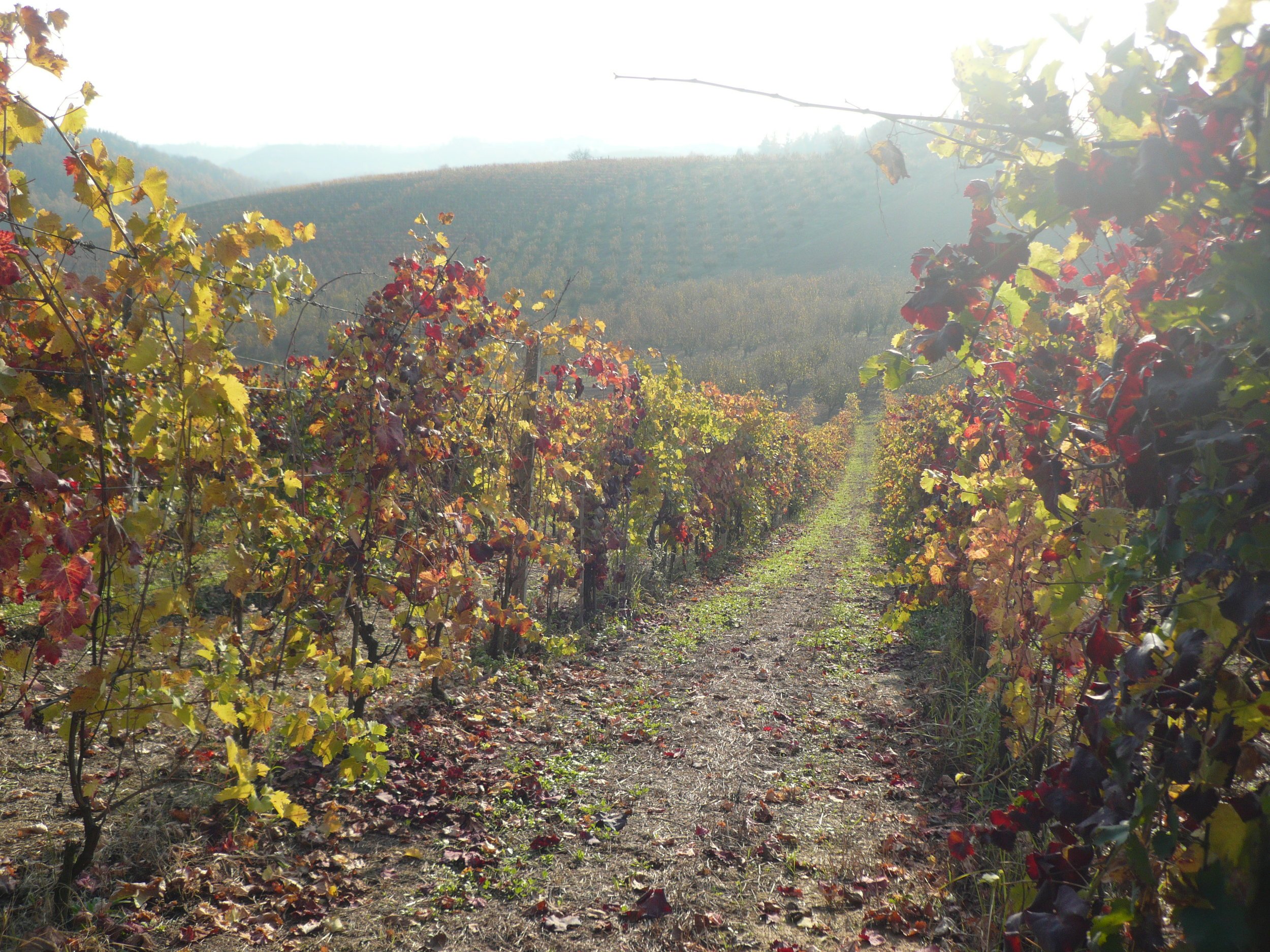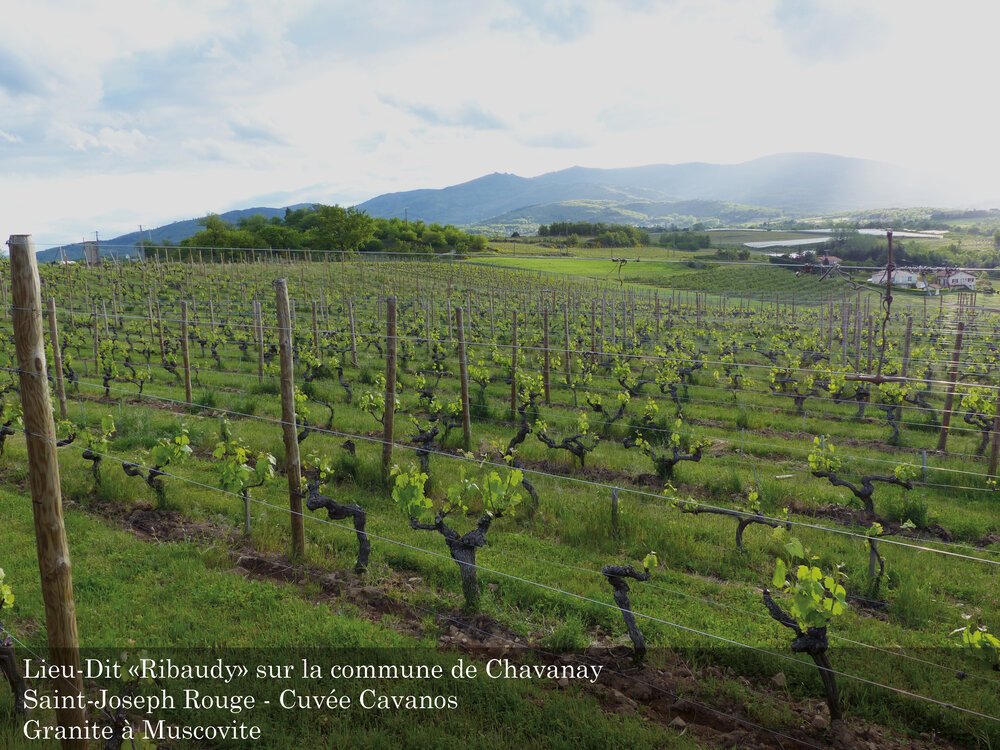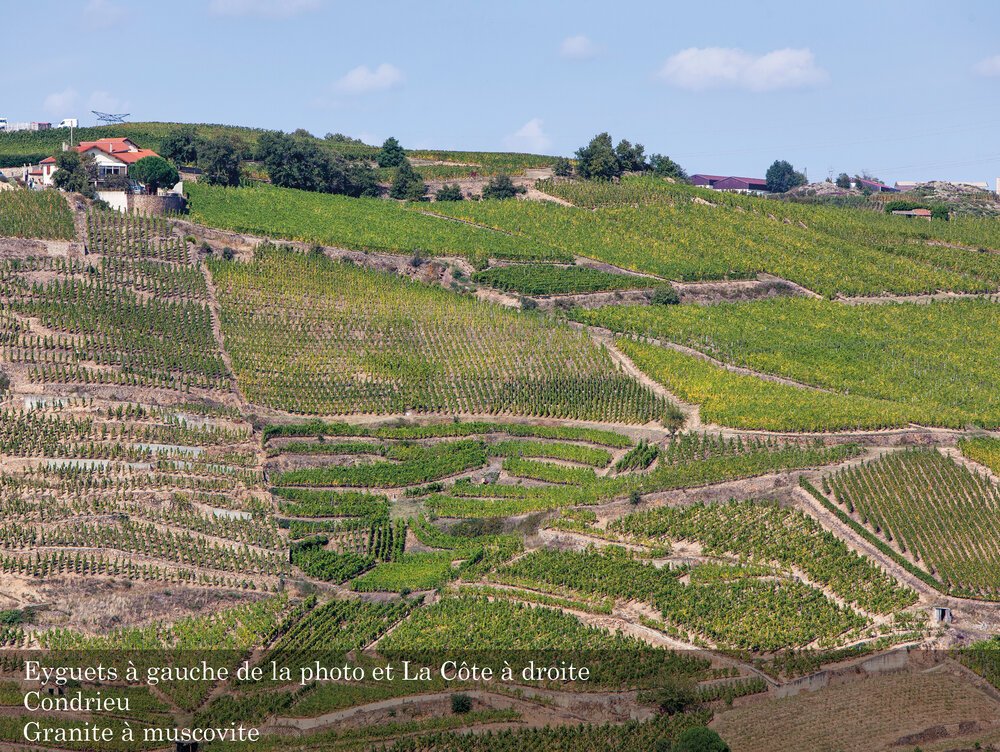
Yves Cuilleron
Chavanay, Rhone, France




The Cuilleron estate, located in Verlieu, a hamlet of Chavanay just south of Condrieu, is one of the benchmark producers of the Rhone. Proprietor Yves Cuilleron makes an assortment of wines from multiple appellations, including Condrieu, Saint Péray, Crozes-Hermitage, Saint Joseph, Cote Rotie, and a range of terrific varietally labelled Vin de Pays from the Collines Rhodaniennes.
First founded in 1920, Yves Cuilleron’s grandfather began bottling his own wine in 1947. Yves’ uncle Antoine ran the winery from 1960 to 1987 and acquired eight hectares of vineyards in the Condrieu appellation, making them one of the more significant estates in the area. Yves took over the family domaine in 1987, added vineyards, and built a new winery and aging facility.
Most of the vineyards are situated in and around Chavanay, while the holdings in Côte-Rôtie extend north into Ampuis, and those furthest south are in the village of Saint Péray. The majority of the vines are set on terraces which makes most mechanization difficult, if not impossible. Thus, the vineyard work continues to be done by hand. To control yields, Cuilleron does extensive debudding and, when necessary, a green harvest.
In the cellar, the manually harvested grapes are fermented using indigenous yeasts. The white wines are fermented in barrels of various sizes and ages and kept on the lees with regular battonage. The reds are partially destemmed, and fermentation occurs in open top cuves. Pigeage and remontage are done regularly throughout the process.
Cuilleron has been described by the wine press as "the leader of Condrieu's new generation of winemakers” and his wines straddle the divide between traditionalists and the new-wave, in the sense that they retain their sense of place, but express their sites in an approachable, immediate way. From simple VdP wines to the top bottlings in Condrieu, St Peray and St Joseph, the wines of Yves Cuilleron offer purity, precision, grace, and joy.
Our Selections
Cuilleron Condrieu La Petite Côte 2023
South/southeast-facing vines in terraces overlooking the village of Chavanay and Verlieu in the middle of the Condrieu AOP. La Petite Côte is not a district but a cuvee brand. Old vines Viognier on muscovite-rich granite, the La Petite Côte is fermented spontaneously using native yeasts. Malolactic fermentation is done in barrels and big casks that are temperature controlled. The wine spends an additional nine months on the lees (no battonage and no racking) in barrel and large casks before bottling.
The Petite Cote exhibits all the distinct and lovely characteristics of Viognier. An exuberant nose with a bouquet of fruits: peach, apricot, quince and citrus, completed by sweet flowers (lilacs, rose, and violet). Fleshy and full on the palate with lovely spice and just a touch of bitterness on the finish that adds balance. This would be an excellent accompaniment to Mediterranean dishes such as a Moroccan lamb tajine with apricots and couscous.
Cuilleron Condrieu Les Chaillets 2022
Les Chaillets Condrieu consists of the best and oldest Viognier vines on the estate, on south/southeast-facing terraces overlooking Chavanay. Les Chaillets is not a district but the local name for the aforementioned terraces. Planted on biotite-rich granite soils, Les Chaillets is fermented spontaneously using native yeasts. Malolactic fermentation is done in barrels and big casks that are temperature controlled. The wine spends an additional nine months on the lees (no battonage and no racking) in barrel and large casks before bottling.
This is a stunning Viognier and a reference point for the area. The wine features beguiling apricot and peach aromas interlaid with sweet spices, mineral notes from the soil, and hints of vanilla cream. The palate is fleshy and full with fresh notes of granitic minerality; a deep and complex wine that is an ideal accompaniment to rich shellfish dishes such as lobster or bouillabaisse.
Cuilleron Saint-Peray Les Potiers 2022
A blend of 50% Marsanne and 50% Roussanne from several parcels of pebble-rich alluvium soils on gentle, southwest-facing slopes in the commune of Saint-Peray. The name Les Potiers is inspired by a neighborhood in the commune of Saint Peray. The wine is fermented spontaneously using native yeasts. Malolactic fermentation is done in barrels and big casks that are temperature controlled. The wine spends an additional nine months on the lees (no battonage and no racking) in barrel and large casks before bottling.
A contrast to the effusive aromatic explosion of Viognier from Condrieu, this St Peray has a delicate, subtle aroma of fresh fruits: peach, Mirabelle, citrus, and lemon rind, along with a strong flint note. A well balanced palate with lovely tension due to the appellation’s mineral soil. This would be a fine accompaniment to scallops, salmon or mussels as well as rich soups.
Cuilleron Saint-Joseph Blanc Lyseras 2021
‘Lyseras’ is blend of 50/50 Marsanne and Roussanne from south and southeast facing vineyards on the hillsides of Chavanay. These vineyards have a naturel cover cropping to avoid erosion. Yves minimizes all treatments in the vineyards and uses no insecticides and only a small amount of organic fertilizer.
The grapes are hand sorted at the winery and after pressing, the must is fermented with native yeasts and then malolactic fermented in barrels and big casks. The wine spends 9 months on lees in barrels with no stirring or racking.
Cuilleron Roussanne Vignes d`à Côté IGP Collines Rhodaniennes 2023
100% Roussanne from vines planted on granitic soils in the communes of Chavanay and Saint-Michel-sur-Rhône. Vignes d’à Coté means “nearby vines” and this wine is so named because the vines are close to the appellations of Condrieu and St. Peray. The grapes are hand-picked, hand-sorted, pressed and are allowed to spontaneously ferment in temperature controlled stainless steel vats. The fermented wine is then transferred to used barrels, where it remains on the lees for six months before bottling.
This is a beautiful, aromatic Roussanne with notes of white flowers, marzipan, citrus, and honey. This is an ideal accompaniment to shellfish.
Cuilleron Viognier Vignes d`à Côté IGP Collines Rhodaniennes 2023
The Viognier Vignes d’à Coté, meaning “nearby vines” is from vineyards of granite and alluvial soils located in the commune of Chavanay, which is close to the Condrieu appellation. The vineyard is sustainable with a natural cover crop to avoid erosion. This 100% Viognier sees a total of six to seven months in oak of varying sizes and ages.
This is an excellent introduction to Viognier with the tell-tale aromas of apricot, nectarine and floral honeysuckle on the nose. The palate is fleshy and ripe, with excellent acidity due to the low pH of the granitic base soils. This is simply a delicious, mouth-watering Viognier from one of the top producers in the Rhone.
Cuilleron Syrah Vignes d`à Côté IGP Collines Rhodaniennes 2023
100% Syrah from vines planted on a mix of granite and alluvial soils. The grapes are handpicked and then sorted, crushed and partially destemmed in the cellar. Fermented in open top, temperature-controlled vats for about 3 weeks, with regular cap-punching and pumping-over. Alcoholic fermentation in vats with native yeasts and malolactic fermentation in barrels. The wine is then aged eight months in a mix of stainless and barrel before being bottled.
This pure Syrah features a beautiful dep purple color with an expressive nose of brambly fruits, spice, and violets. The palate practically bursts with fruits des bois and an excellent granitic, mineral finish.
Cuilleron Saint-Joseph Rouge Cavanos 2021
A selection of 20-40 year old Syrah vines from hillside terraces on muscovite-rich granite soils, Cavanos is the ancient name for the village of Chavanay. The grapes are hand- picked; and then sorted, crushed and partially destemmed in the cellar. Fermented in open top, temperature-controlled vats for about 3 weeks, with regular cap-punching and pumping-over. Primary fermentation is in vats with native yeasts and malolactic fermentation in barrels followed by an additional 16 months in barrel.
Cavanos features deep, dense aromas of sweet brambly fruit framed by a hint of classic Syrah smokiness. Juicy well balanced palate with velvety tannins and excellent length.
Cuilleron Crozes Hermitage Rouge Labaya 2021
The Crozes Hermitage Laya comes from two hectares of vines from the “Malfondière” plot situated just south of Tain l’Hermitage. Laya is an old name district of Tain l’Hermitage. This is obviously all Syrah from deep, stony, sandy, loamy soils. The grapes are handpicked; and then sorted, crushed and partially destemmed in the cellar. Fermented in open top, temperature-controlled vats for about 3 weeks, with regular cap-punching and pumping-over. Alcoholic fermentation in vats with native yeasts and malolactic fermentation in barrels. The wine is then left to age for 16 months before bottling.
This is a juicy, full-bodied version of Crozes with high-toned red and black fruit notes. This is substantial wine with plenty of ripeness and acidity.
Also available in half-bottles!
Cuilleron Cornas Le Village 2022
Le Village is an assemblage of Syrah from three granitic, terraced vineyards in Cornas: "Les Côtes", "Reynard" and "Cayret". Like his other reds, the grapes are hand-harvested, sorted, then crushed, with partial de-stemming in the cellar. Fermented in open top, temperature-controlled vats for about 3 weeks, with regular cap-punching and pumping-over. Alcoholic fermentation in vats with native yeasts and malolactic fermentation in barrels. The wine ages in barrique for 18 months before bottling.
This is a showcase for classic syrah flavors in high-definition: baked black fruits and berries, garrigue, spice, and a touch of roasting meat. Delicious with some heft on the palate, yet Yves finesses something neither over-wrought nor over-powered. Well balanced and cellar-worthy.
Cuilleron Côte-Rôtie Bassenon 2022
Yves farms about 9 hectares in Côte-Rôtie and his Bassenon comes from 1.5ha in the southern part of the appellation on the Coteau de Semons, in the Tupin-Semons commune. The Syrah (90%) and Viognier (10%) that make up the cuvée are grown on steep slopes of granite and gneiss typical of the Côte Blonde.
The grapes are hand-harvested, sorted, then crushed, with partial de-stemming in the cellar. Fermented in open top, temperature-controlled vats for about 3 weeks, with regular cap-punching and pumping-over. Alcoholic fermentation in vats with native yeasts and malolactic fermentation in barrels. The wine ages in barrique for 18 months before bottling.
Bassenon is absolutely seductive, with its deep, dense purple color and nose full of blackberries and flowers. The palate has a lovely fine-grained, silky texture with the minerality of the granite and gneiss soils bringing elegance. Super precise in execution, Yves proves once again that his reds strike that perfect mineral-fruit balance just like his whites.
Cuilleron Ripa Sinistra 2022
Yves is particularly excited about this wine. Latin for “left bank”, Ripa Sinistra is a vineyard on the left bank of the Rhone, just across the river from Cote-Rotie. With the same granitic soils that can be found in Cote-Rotie, this 14 hectares site has massive potential and is already producing wines of significance. This is an ancient vineyard first planted by the Romans that was abandoned between the late 1800s and when it was replanted in 1996!
Yves himself has one hectare of the fourteen, while his collaborative Vins de Vienne project (with François Villard and Pierre Gaillard) farms a bulk of the vineyard. However 20 other producers who also farm here.
Though labeled IGP now, next year this site will be promoted to Côtes du Rhône AOC. Yves thinks it will jump past Côtes du Rhône Villages AOC and receive full appellation status within three years.
Here we have high-density planting (8,000-10,000 vines per hectares) with natural cover cropping to avoid erosion. No insecticides and treatments are only used when absolutely necessary. The grapes are hand harvested and then sorted, crushed, and partially destemmed in the cellar. Fermented in open top, temperature-controlled vats for about 3 weeks with regular cap-punching and pumping-over. Alcoholic fermentation in vats with native yeasts and malolactic fermentation in barrels. The wine ages for 18 months in barrel before bottling.
Ripe black fruit, smokey and saline suggestive of granitic soils found here. Full-bodied and not shy, even when opened young. So much spiciness and salinity on the palate as well with tremendous length.
Cuilleron Durif Anciens Cepages 2022
About a decade ago, Yves embarked on a new project planting massale selections of six nearly-extinct native grape varieties once prevalent in the Rhône hillsides. Today these micro-batch ferments uncover and celebrate the rich historical roots of Cote Rotie, Condrieu, Cornas, and Champagne that predate the dominance of Syrah, Viognier, and Chardonnay. With the Anciens Cepages wines, Cuilleron has sought to revive the lost flavors of the Rhône and chart a course towards greater viticultural diversity in the region
One of these grapes — Durif — might sound familiar. More commonly known as Petit Sirah, early California wine growers mistook their cuttings and planted Durif instead of Syrah, hence the variety’s proliferation on the West Coast as “Petit Sirah”.
The grape does indeed have Syrah parantage. In the 1860s, Dr. Francois Durif found a crossing of Peloursin with Syrah in his nursery and it was named Plant du Rif. Later renamed Durif, the grape found popularity in the Northern Rhône and according to local documentation, nearly 500 hectares of Durif was planted in-and-around Cote Rotie, Saint Joseph, and Crozes Hermitage as of 1880. Today, you’ll find a mere 2 hectares, most of which is used for Yves’ wine. From this, only about 80 cases are produced each vintage.
In the Cuilleron line-up, Yves’ Durif has a viceral richness and power. A bit different from his syrah-based wines, this is delicious when opened young with super juicy black fruits.
Cuilleron Condrieu Doux Essence d’Automne 2018
This beautiful dessert wine from Yves Cuilleron is made only in years in which there are enough botrytis-affected grapes. The Essence d’Automne is made from 100% Viognier planted on south-facing terraces overlooking the village of Chavanay. Their orientation and sensitivity to botrytis allow for concentrated grapes with a high level of sugar as well as botrytis-affected grapes. Multiple passes are made in the vineyard from October through mid-November, a month after the dry cuvees have been harvested. Temperature controlled fermentation is used to slowly create this beautiful dessert wine with 110 grams of residual sugar and about 5.5 g/l acidity.
The wine, formerly known as Ayguets, is mind-bendingly complex, with aromas of white pear, dried apricot, peach and green tea. The palate is rich and full with a silky texture and enough dry extract to offer good structure. The wine is surprisingly balanced for a late-harvest Viognier. Feature this wine as dessert rather than paired with dessert. It would also be excellent with blue cheese, savory tarts or foie gras. (500ml)
Cuilleron Roussilliere Vin de France Doux 2023
A sweet expression from cuilleron that is one third each Marsanne, Roussanne, and Viognier. Grapes are harvested when overripe by successive sorting. 8 months of aging in barrels. The nose expresses notes of quince, honey and candied pear. Wonderful roundness on the palate accenty by a tangy, citrus-forward finish. Drink now or with evolving notes of curry and spices. Perfect with blue cheeses and desserts. (500ml)















